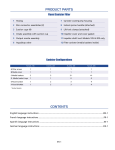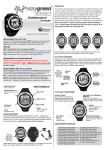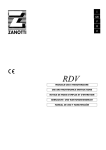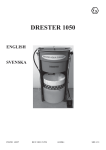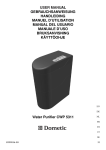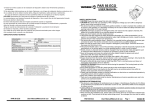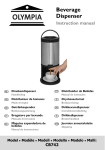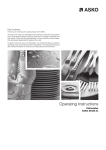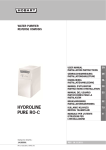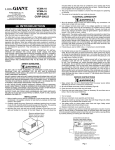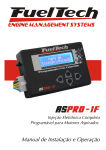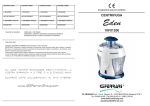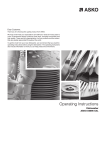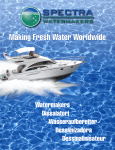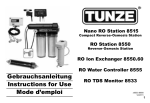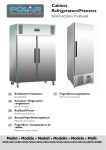Download instructions manual
Transcript
USER INSTRUCTIONS Confidence WATER PURIFIER REVERSE OSMOSIS RO 400 EN DE FR ES IT 8229016-28 SE PRODUCT DESCRIPTION EN 1. Bracket for reject water hose 2. Reject water hose 3. Hose clips (2) 4. Hose for feed water 5. Angle bracket for purified water hose 6. Filter spanner 7. Information decal 8. Purified water hose 9. Purfied water tap 10. Indicator lights 11. Filter container I 12. Base plate 13. Filter container II 14. Control panel ES 1. 2. 3. 4. 5. DE 1. Knickschutzbogen für Abwasserschlauch 2. Abwasserschlauch 3. Schlauchschellen (2) 4. Zulaufschlauch 5. Knickschutzbogen für Reinwasserschlauch 6. Filterschlüssel 7. Informationsschild 8. Reinwasserschlauch 9. Reinwasserhahn 10. Anzeigeleuchten 11. Filterbehälter I 12. Bodenplatte 13. Filterbehälter II 14. Kontrolltafel IT 1. Supporto tubo acqua reflua 2. Tubo di scarico dell’acqua reflua nella tubazione fognaria 3. Fascetta stringitubo (2) 4. Tubo acqua di alimentazione 5. Gomito per tubo acqua trattata 6. Chiave speciale per filtri 7. Etichetta informative autoadhesiva 8. Tubo acqua trattata 9. Rubinetto acqua trattata 10. Spie 11. Contenitore filtro I 12. Piastra di base 13. Contenitore filtro II 14. Pannello di comando FR 1. Étrier pour tuyau d’évacuation des eaux usées 2. Tuyau d’évacuation des eaux usées 3. Attache pour tuyau (2) 4. Tuyau d’amenée de l’eau 5. Raccord coudé pour tuyau de sortie de l’eau purifiée 6. Clé pour installation des filtres 7. Fiche d’information auto-adhésive 8. Tuyau de sortie de l’eau purifiée 9. Robinet pour l’eau purifiée 10. Voyants d'indication 11. Compartiment filtre I 12. Socle 13. Compartiment filtre II 14. Tableau de commande SE 1. Hållare för avloppsslang 2. Avloppsslang 3. Slangklämma (2) 4. Tilloppsslang 5. Vinkelhållare för renvattenslang 6. Filternyckel 7. Informationsdekal 8. Renvattenslang 9. Renvattenkran 10. Indikeringslampor 11. Filterbehållare I 12. Bottenplatta 13. Filterbehållare II 14. Kontrollpanel 2 Abrazadera de la manguera de desagüe Manguera de desagüe Abrazaderas para manguera (2) Manguera del agua de alimentación Escuadra para la manguera de agua purificada 6. Llave de tuercas del filtro 7. Adhesivo informativo 8. Manguera de agua purificada 9. Grifo del agua purificada 10. Pilotos indicadores 11. Portafiltros I 12. Base 13. Portafiltros II 14. Panel de Control PRODUCT DESCRIPTION 9 10 1 2 8 3 4 14 7 53 6 13 12 11 3 Confidence RO 400 EN THANK YOU for entrusting us to supply your new water purifier, which we hope will provide you with many years of trouble-free use. To avoid problems, it is important for you to read through the user instructions and carefully to follow the “Safety information” and the “Installation” instructions. Everybody using the water purifier should be familiar with how to operate it and its safety features. The manual should be kept and stay with the water purifier if it is ever moved or changes owners, so that everyone who uses the appliance can read about the various functions and safety instructions. The manual’s English instructions begin on page 5. DE VIELEN DANK, dass Sie unseren Wasseraufbereiter gewählt haben. Wir hoffen, dass Sie viele Jahre Freude an dem Gerät haben werden. Um Probleme zu vermeiden, ist es wichtig, diese Gebrauchsanweisung aufmerksam zu lesen und die Anweisungen und Informationen der „Sicherheitshinweise“ und der „Installationsanleitung“ zu beachten. Alle, die den Wasseraufbereiter benutzen, sollten mit seiner Bedienung vertraut sein und wissen, was in einem Störungsfall zu tun ist. Dieses Handbuch ist immer bei dem Wasseraufbereiter aufzubewahren. Geben Sie diese Unterlagen im Falle eines Verkaufs an den neuen Besitzer weiter. Die deutschen Bedienungsanweisungen dieses Handbuchs beginnen auf Seite 27. FR MERCI de nous faire confiance en optant pour votre nouveau purificateur d’eau qui, nous l’espérons, vous servira sans défaillance et vous donnera satisfaction pendant de nombreuses années. Afin d’éviter tout problème, ne manquez pas de lire la section intitulée « Sécurité », ni de vous conformer scrupuleusement aux instructions d’« installation ». Quiconque utilise le purificateur devra en connaître le maniement et les dispositifs de sécurité. Conserver avec soin le présent manuel d’instructions et veiller à ce qu’il accompagne le purificateur en cas de déplacement ou de vente de ce dernier, de façon à ce que tout utilisateur puisse à tout moment consulter le manuel d’instructions complet et les instructions de sécurité. Le manuel d’instructions en français commence à la page 49. ES GRACIAS por confiar en nosotros al adquirir su nuevo purificador de agua del que esperamos que disfrute por muchos años sin ningún tipo de problema. Para evitar problemas, es importante que lea el manual de instrucciones y que siga con atención la “Información sobre seguridad” y las instrucciones de “Instalación”. Cualquier persona que utilice el purificador de agua deberá estar familiarizada con el funcionamiento y las advertencias de seguridad. Conserve el manual próximo al purificador de agua, incluso si se coloca en otro sitio o cambia de propietario, para que quien lo utilice pueda conocer las distintas funciones y las instrucciones de seguridad. El manual de instrucciones en español comienza en la página 71. IT GRAZIE per la fiducia che ci avete accordato acquistando questo nuovo depuratore d'acqua. Siamo certi che potrete contare sul suo perfetto funzionamento per molti anni. Per evitare problemi, è importante che l'utente legga attentamente le seguenti istruzioni, prestando particolare attenzione ai capitoli «Informazioni sulla sicurezza» e «Installazione». Chiunque utilizza un depuratore dovrebbe conoscere le modalità di funzionamento e le caratteristiche di sicurezza di tale apparecchio. Conservare il presente manuale assieme al depuratore. Se l'apparecchio viene spostato o ceduto a un altro proprietario, l'utente deve sempre avere la possibilità di consultare la documentazione relativa alle varie funzioni e alle istruzioni di sicurezza. Le istruzioni in italiano del manuale iniziano a pagina 93. SE TACK för att vi fick förtroendet att leverera din nya vattenrenare som vi hoppas du ska få många års bekymmersfri användning av. För att undvika problem är det viktigt att du läser igenom bruksanvisningen och noga följer säkerhetsinformationen och installationsanvisningarna. Alla som använder vattenrenaren ska vara väl förtrogna med användningssättet och säkerhetsdetaljerna. Spara bruksanvisningen och låt den följa med vattenrenaren vid flytt eller ägarbyte, så att alla som använder vattenrenaren kan läsa om funktionerna och säkerhetsdetaljerna. Bruksanvisningens svenska instruktion börjar på sida 115. 4 CONTENTS For the user For the installer GENERAL VIEW OF THE APPLIANCE 2-3 TECHNICAL DATA 19-20 CONTENTS 5 INSTALLATION INFORMATION 6 Where to install the water purifier ..................21 21-25 Unpacking......................................................21 Consumables/accessories ..............................6 Recycling of materials ....................................6 A brief glossary................................................6 7-8 SAFETY INFORMATION Concerning the use of the water purifier ........8 Concerning installation and service ................8 Child safety ......................................................8 9 USING THE WATER PURIFIER Apply the information panel ..........................21 Electrical and plumbing connections ............22 To fit the tap for purified water ......................22 Connecting the reject water hose ..................23 Connecting the feed water hose ....................23 Connecting up the appliance ........................24 The flushing procedure..................................25 Calibration ....................................................25 Moving the water purifier ..............................25 To draw purified water......................................9 10-15 MAINTENANCE Replacing the filters..................................10-11 Descaling..................................................12-13 Disinfection ....................................................13 Preparing the water purifier for storage and protecting it against freezing ..................14 To clean the grid ............................................15 REGULAR CARE OF WATER PURIFIER 15 Points to remember ......................................15 IF THE WATER PURIFIER STOPS WORKING 16-18 Trouble-shooting table ..............................16-17 To adjust the tap ............................................18 Service and spare parts ................................18 Guidelines for using the user instructions The following symbols in the text will help you to read the user instructions: Safety information Environment information Step-by-step instructions Tips and information 5 INFORMATION Consumables/accessories Item Filter inserts: Filter I (particle filter) Filter II (carbon filter) Descaling/cleaning agent for Water Purifiers Preservative and Antifreeze liquid for Water Purifiers Sound absorbing carpet Installation pack Connector for dishwashers (level-control type only) Item no. Part no. 919 24 00-82 Part no. 919 24 00-83 Part no. 150 72 07-01 Part no. 150 72 06-02 Part no. 919 24 09-03 Part no. 919 24 09-04 Part no. 919 24 09-02 Accessories and consumables can be ordered from your dealer. When ordering, please quote the relevant part number from the list above. Recycling of materials The materials used in 80% of the plastic and rubber components of this product and its packaging are identified by symbols to assist the process of recycling and disposal. The materials are marked according to international standards. The cardboard parts of the packaging are made from recycled paper and should be deposited at a suitable recycling point. A BRIEF GLOSSARY 6 Reverse osmosis The purification of water by forcing it under pressure through a semipermeable membrane. The membrane is impermeable to impurities, but permeable to water. This is the principle upon which the water purifier is based. This form of purification does not rely on chemicals. Membrane The membrane made of semipermeable material used in the water purifier to purify water by reverse osmosis. Filters Used to separate out material before the water reaches the membrane, prolonging the life of the membrane: grid (a coarse filter) particle filter (Filter I ) carbon filter (Filter II ) SAFETY INFORMATION The Confidence RO 400 is a very safe appliance, but even so it is important that everyone using it should be thoroughly familiar with the way it works and its safety features. To prevent mishaps and problems you should read the “Safety Information” on these pages, and carefully follow the instructions in the “Installation” section. Take care of this manual and make sure that it accompanies the water purifier if it is moved or sold. • The water purifier may only be installed with the accompanying tap. The water purifier must not be connected so as to supply all the taps in the property with water. There is a risk of corrosion in water pipes and water-heaters. Neither may the water purifier be installed in connection with valves, switches or tanks. Any faults that arise in a water purifier that has been incorrectly installed are not covered by the guarantee. • Check that the water you intend to purify meets the requirements listed under “Requirements of feed water”, in the section “Technical data”. • When the water purifier is brand-new, the purified water must not be consumed until after the calibration and flushing procedures have been completed. • Calibration of the water purifier should only be carried out: – the first time that the water purifier is used – if the appliance is moved to a different place (locality) where the water quality is different – after the membrane has been replaced • When the membrane contains the special products for storage or descaling, it will have to be cleaned by following the “Flushing procedure” before the water from the water purifier may be used again. • The water produced by the appliance may only be consumed if Purification Level indicator II or III on the control panel comes on. A green indicator light on the tap will come on at the same time. • If the feed water supply to the appliance is unfit for consumption, have the purified water from the appliance tested after installation. You should subsequently have the purified water tested once a year, or if any change in its taste or smell occurs, to ensure that the water purifier is functioning well. If the result is unsatisfactory, do not drink the water. Contact your dealer. • If any leakage arises, turn off the supply of water to the appliance immediately and disconnect the appliance from the electrical supply by removing the electrical plug from the wall socket, or if necessary, removing the relevant fuse • If the water purifier is to be disconnected from water and electricity for an extended period (1 week), it should be stored as described in “Preparing the water purifier for storage and protecting it from freezing”. This also provides protection against freezing. • Do not attempt to modify or otherwise alter the water purifier in any way. Doing so could result in personal injury and/or damage to property which would not be covered by any warranty. • Once every month you should check that the connections are all watertight. Leakages outside the appliance cannot be detected by the appliance's leakage protection system. • If the water purifier is malfunctioning, it should be isolated from the electrical supply by removing the electrical plug from its socket. If this is not possible, remove the relevant fuse or switch off the circuit breaker at the electrical distribution board (consumer unit). • At the end of the appliance's useful life, disconnect the electrical plug from the power supply, then cut the electrical lead at the point where it enters the appliance. Make quite sure that children will not be able to play with the severed lead. To find out how best to dispose of the appliance, contact your dealer or the local authority. 7 SAFETY INFORMATION Concerning the use of the water purifier Concerning installation and service • The water purifier is designed to produce the quantity of water normally required for cooking, drinks, washing dishes and general household duties. • The water purifier must be connected to an earthed electrical supply. We recommend use of a plug-in connection to a wall socket, since certain procedures such as replacing filters and preparing the appliance for storage if it will not be used for a time require the power supply to be disconnected, then reconnected. Using an electrical plug also makes it easier to move the appliance. • The appliance needs to remain connected to the water and electrical supplies so that its automatic flushing system can work. The appliance will carry out flushing automatically every 12 hours (approximately). • The appliance must not be operated without the filters being in place (except during the descaling or storage procedures). Doing so can cause serious damage. • If the appliance is to have fixed wiring to the electrical supply, this work must be carried out by a qualified tradesman. Installation work which has not been carried out properly can result in serious personal injury and/or damage to property which are not covered by any warranty. • If the tap is left on for longer than 20 minutes the water purifier will shut down automatically. The appliance is designed to do this mainly to maximise the service life of the membrane. To restart the appliance, follow the instructions in the “Trouble-shooting table”. • Any plumbing work required should be carried out by a qualified tradesman. If you do any of the installation work yourself, you must check the regulations which apply to this and comply with them. • The top of the water purifier should not be used as a place for storing anything. • It is important that the water purifier should be installed in the upright (standing) position. • Do not use the water from the appliance in aluminium saucepans etc., on account of the risk of corrosion, which would also cause increased levels of aluminium in the water. • Make sure that hoses and leads do not get crushed or otherwise damaged when the water purifier is being moved, e.g. during installation or cleaning. • The appliance will flush automatically after water is drawn from it and also whenever the electrical supply is reconnected. See “To draw purified water”. • The water purifier must not be plumbed in to supply the entire dwelling with water, since this could cause corrosion inside water pipes and hot water heaters. For the same reason, no tap should be used for drawing the water from the appliance other than the one supplied or one recommended by your dealer. Child safety • Never leave packaging material lying around so that children can play with it. • Do not let children play with the water purifier. 8 USING THE WATER PURIFIER Once the water purifier has been installed and calibrated according to the “Installation” instructions, it is ready for use. The water purifier has an electronic control system which makes it easy for you to use. Normally you will only need to remember a few points: • To replace Filters I and II once or twice a year, or when the indicators on the front panel show they need replacing. • To descale the water purifier at the intervals recommended. To draw purified water The water purifier produces purified water when the tap is moved to either of the “On” positions shown in Fig. B. When the tap lever is moved to Position 1, the tap will stay on (hands-free) at maximum flow until the lever is moved back manually to the “Off” position. The lever has to be pressed and held when Position 2 is used (also maximum flow). The indicator lights on the tap show the current water quality: green light: optimum water purification level red light: unacceptable water purification level B 1 On Off 2 On If the water purifier has not been used for a time, it may take up to 60 seconds before the optimum water purification level is reached, as shown by lights on the tap and control panel. The water purifier has automatic features designed to optimise the service life of the membrane: • Just after you draw water each time, the appliance will switch to flushing mode automatically, to clean the membrane. The length of this flushing will vary (5 to 90 seconds) according to how long the tap was open. If the tap is left on for longer than 20 minutes, the appliance will shut down automatically. To restart it, follow the instructions in the “Trouble-shooting table”. • The appliance will switch automatically to flushing mode for a brief period once every 12 hours (approximately), provided the water and power supplies are connected. This periodic flushing takes place no matter when the appliance was last used. When using the water purifier, it is sensible to fill a jug with drinking water while it is operating. Try to avoid starting it working just to fill a single glass at a time. This helps save water, because each time the appliance purifies water, a certain amount is lost (via the reject water outlet) before the optimum purification level is reached, and the water purifier also switches to flushing mode after it is used. 9 MAINTENANCE Replacing the filters It is important to replace the filters as soon as they need replacing, since their main function is to protect the membrane. Check for any signs of leaks just after you have replaced them and again after you have used the appliance a few more times. TO REPLACE FILTER I Replace filter I when the indicator lamp for filter I comes on. 1 Make sure that the tap for purified water is turned off and that the appliance is not flushing. 2 Disconnect the electrical plug. Open the front cover (in front of the two filters) as shown in the illustration. 3 Pull the filter containers outwards as far as they will come. 4 Use the filter spanner to undo the container to the left marked I. Bear in mind that the container will be full of water and that some water may spill! 5 Mop up any water inside the base of the appliance. 6 Remove the old filter. 7 Clean the filter container with water and a brush. 8 Put the new filter in place, with the I label pointing upwards. Make sure that the sealing ring is in place in the grooves of the filter container. 9 Refit and tighten the container using the filter spanner. Tighten the filter container so that the dot is somewhere between the two outermost white lines. 10 Slide the filter containers back into the appliance. 11 Close the front cover and reconnect the electrical plug. Flushing will take place automatically. This completes the procedure for replacing filter I, and the water purifier is ready for use again. TO REPLACE FILTER II Replace filter II when the indicator lamp for filter II comes on, and when you notice a three-second delay before the motor starts up each time you turn on the tap. 1-11 Work through the 11 steps in the instructions for replacing filter I, but remove container II instead (on the right), and replace the filter in that. 12 For filter II you have to finish by resetting the appliance. Make sure that the tap (purified water) is turned off and the electrical supply is connected. Then press the Calibration button on the control panel, and keep it pressed inwards until the pattern of indicator lights for filter II has gone out (takes about five seconds). This completes the procedure for replacing filter II , and the water purifier is ready for use again. 10 MAINTENANCE 11 MAINTENANCE Descaling In time, the substances which the appliance removes from your drinking water tend to clog the membrane and will eventually reduce the flow of pure water from the tap. To prolong the service life of the membrane, it has to be descaled periodically. FREQUENCY OF DESCALING When you notice that the flow rate from the tap has decreased, you need to follow the descaling procedure below. The time schedule for how often you will need to do this will depend on your particular water supply, especially on its levels of calcium (“hardness", see table, right), iron, manganese and possibly silicon, as well as of microorganisms. Even with regular descaling, the maximum flow of purified water from the appliance will decrease gradually on account of the normal properties of the membrane. When you notice that,despite descaling, the flow is about half of what it was when the membrane was new, it is time to replace the membrane. You should descale your water purifier: • when the flow of water from the tap has decreased • at the intervals recommended in the table (right) The correct descaling product for this appliance can be ordered from your dealer (see “Optional accessories and consumables”). 1 Disconnect the electrical plug, then plug it back in again to make the appliance switch to flushing mode. 2 Make sure that the tap for purified water is turned off and that the appliance has finished flushing. Leave the electrical supply to the appliance on. 3 Undo filter container II as described under “Replacing the filters”, steps 3–7. 4 Measure 250 ml (corresponds to 200 grams) of the descaling agent into the container. Fill the container almost to the top with lukewarm water (20 – 40 °C). Stir until the powder has dissolved, see Fig. A. 5 Screw the container into place with the aid of the filter spanner. 6 Turn on the tap for purified water and let the water purifier operate for 45 seconds. 12 Frequency of descaling -7 every 6 months 50 - 100 - 14 every 3 months 100 - 140 - 20 every month - 50 Descaling the appliance takes about ten hours, during which time you will not be able to use the appliance. The descaling product must be kept out of the reach of children. Wash your hands after using it. Hardness °d Calcium Ca2+ & magnesium Mg2+ mg/l A MAINTENANCE 7 While the tap is still on (open), disconnect the electrical plug, see Fig. B. Then turn off the tap. Now leave the water purifier like this for about 10 hours (e.g. over night). 8 At the end of the 10 hours, undo the container. Discard its contents and rinse it with water. 9 Put the filter back in the container and follow steps 8–11 as described under “Replacing the filters” (except that you put back the filter which has already been used). 10 Work through all the steps of the “Flushing procedure” This completes the descaling procedure. The water purifier is ready for normal use again. B Disinfection If the appliance has not been used for a time (several days), there may be a build-up of microorganisms on the membrane and the water may develop a certain odour. If this is the case, it is advisable to disinfect the water purifier, and change filters I and II. The disinfectant, sodium hypochlorite 3.5%, odourless, can be bought from supermarkets or from the chemist. The water has to be odourless after the disinfection. The disinfectant must be kept out of the reach of children. 1 Disconnect the electrical plug, then plug it back in again to make the appliance switch to flushing mode. 2 Undo filter container II as described under “Replacing the filters”, steps 3–7. Discard the filter. 3 Fill the container three-quarters full of lukewarm water, and add 25 ml of the correct disinfectant, see Fig. C. 4 Screw the container (containing the solution) back onto the appliance with the aid of the filter spanner. 5 Turn on the tap for purified water and let the water purifier operate for 45 seconds. 6 While the tap is still on (open), disconnect the electrical plug, see Fig. B. Then turn off the tap and leave the water purifier like this for about 30 minutes. 7 Restart the water purifier by reconnecting the electrical plug to the wall socket, let it flush automatically. 8 Undo the filter containers and insert a new filter II. Also change filter I according to “Replacing the filters”. 9 Refit the front cover. 10 Work through all the steps of the full “Flushing procedure”. C 13 MAINTENANCE Preparing the water purifier for storage and protecting it from freezing A The water purifier should be put into storage if: - it is to be disconnected from water and electricity for an extended period (1 week or more). - it is not going to be used for a period longer than four months. You can choose between two ways of mixing the storage fluid depending on the desired protection against freezing: - 2 litres of storage fluid + 4 litres of water provide protection against freezing down to –15°C. - 3 litres of storage fluid + 3 litres of water provide protection against freezing down to –30°C. The correct product (“Preservative and Antifreeze Liquid”) can be ordered from your dealer (see“Consumables and accessories ”). This product must be kept out of the reach of children. 1 Close the valve on the water supply pipe. Disconnect the electrical plug and the hose for feed water. See Fig. A. 2 Undo both filter containers as described under “Replacing the filters”, steps 3–6. Remove the two filter inserts and discard them (should not be kept for re-use). Empty the water from the containers. 3 Reinstall the empty filter containers back in their normal places. Make sure that each sealing ring is in place in the groove on the top edge of each container. 4 Mix the “Preservative and Antifreeze Liquid” with water in a bucket, dosage, see above. 5 Put the end of the hose (feed water) into the mixture. Make sure that the end of the feed water hose remains beneath the surface throughout, see Fig. B. 6 Connect the electrical plug again. The water purifier will now automatically pump the mixture inside the appliance. After 40 seconds, disconnect the electrical plug. Repeat this step until all the mixture has been drawn up. Disconnect the electrical plug. Leave the tap open and disconnect the inlet hose and the pure water hose from the water purifier. Disconnect the pure water hose by pressing in the grey ring on the connection and pulling out the hose, see fig. C. You have now prepared the water purifier for storage. It can be left in this state for up to nine months. When the water purifier is to be brought back into use you must: • stand it somewhere where the temperature is above +5 °C for at least 48 hours. • Work through all the steps of the full “Flushing procedure”, to remove the preservative. • Install new filters I and II, see “Replacing the filters”. 14 B C MAINTENANCE D To clean the grid The grid (a coarse filter) is designed to intercept large particles and is located inside the connection for the feed water on the appliance. If the indicator lamp for filter I shows that the intake pressure is too low, the reason may be that the grid is clogged. 1 Turn off the tap for purified water. Disconnect the appliance from the electrical supply. 2 Close the valve on the water supply pipe. 3 Undo the feed water hose connector on the appliance. 4 Use suitable pliers to grip and remove the grid (Fig. D). 5 Clean the grid and run water through it before putting it back inside the connector. 6 Reconnect the feed water hose to the appliance. 7 Open the valve on the cold water supply pipe and check that there are no leaks. 8 Connect the appliance to the electrical supply again. It will flush automatically. REGULAR CARE OF WATER PURIFIER Listed below are the things you need to remember in the regular care of your water purifier. The points are listed in the order of frequency, starting with daily checks. Points to remember • Check the indicator lights every day, in case there is some state or function which needs attention. • The everyday care of the water purifier consists basically of keeping it clean. The outside of the appliance should be cleaned with a damp cloth only. Do not use a wet cloth and do not pour water over it for cleaning. Do not use any cleaning agents. • Once a month check that all connections to the appliance are properly secured and watertight. Wipe dry any condensation which may have accumulated inside the appliance base. Leakages outside the appliance cannot be detected by the appliance's leakage protection system. • The appliance needs to be descaled at regular intervals. The frequency depends on the hardness of the water supply and its microbial content. • Be sure to replace the filters as soon as necessary. The life of these filters is determined by (amongst other factors) the levels of impurities in your water supply. If the water supply has been classified as unfit for drinking, the water from the appliance should be tested once per year. • After replacing filters leave the discarded filter insert to drain for a few minutes. These filters can be discarded in your ordinary household refuse, since they do not contain any substances which are hazardous to the environment. 15 IF THE WATER PURIFIER STOPS WORKING Trouble-shooting table To protect both the user and the appliance itself from incorrect use, the water purifier has built-in warning (alarm) devices which cause it to stop working under certain conditions. The table below lists these warnings and their probable causes. The indicator lights have three statuses: Light off Light on Light flashing SYMPTOMS wandering 16 POSSIBLE CAUSE ACTION TO TAKE Time to replace filter or clean the grid. • There is time before the water purifier experiences an emergency stop. Prepare to replace filter I and to clean the grid. The feed water’s pressure is too low, i.e. less than 1.5 bar (150 kPa) • Check the feed pressure. If necessary, increase the pressure to 1.5-10 bar (150-1000 kPa) Warning that filter I or II is blocked. • Check that there is nothing inside the filter containers which could be blocking the flow. • If necessary replace filter I or II. Warning of blockage in grid. • Check the grid. See the section “To clean the grid”. Warning of leakage/condensation inside the base under the filter containers. • Check that all connections are watertight. • If there is water inside the base, wipe it dry (tilt appliance forward if necessary). The intake water pressure is too low, i.e. less than 1.5 bar (150 kPa). • A booster pump to increase the pressure to the water purifier can solve this problem. • Check all the factors which can affect water pressure (water supply, grid, special filters). Warning that filter II needs replacing. • Replace filter II . See “Replacing the filters”. Warning of reduced water quality. • If the appliance is new and has never been calibrated: calibrate the appliance (see “Calibration”). • Restart the water purifier (by disconnecting then reconnecting the electricity) so that the appliance switches to flushing mode. Repeat this procedure two or more times. Warning that the tap has been on for more than 20 minutes without a pause, and that the appliance has shut down automatically as a result. • Turn off the tap and leave the water purifier undisturbed for at least 30 minutes. • Restart the appliance by disconnecting and then reconnecting the electricity. • After automatic flushing the water purifier will be ready for use again. Warning that calibration has been started, but not completed correctly (probably because the tap has been turned off before the full 10 minutes). • Restart the appliance by disconnecting and then reconnecting the electricity to start flushing mode. • Recalibrate the water purifier, see “Calibration”. Warning of error in water quality meter. • Restart the appliance by disconnecting and then reconnecting the electricity to start flushing mode. Wait for two hours. Turn on the tap, wait for 2 minutes. IF THE WATER PURIFIER STOPS WORKING SYMPTOMS POSSIBLE CAUSE ACTION TO TAKE Low water flow The membrane may be clogged. • Descale the appliance. See “Descaling”. The appliance starts working on its own (briefly, without tap being turned on). The hose for purified water is not pressed all the way home at the connection on the appliance. Alternatively there may be a leak at the connection of hose to tap, or the hose for this tap may have been shortened (cut) incorrectly. • Check all connections. • Check that both ends of the hose for purified water are cut straight and clean, and not deformed. Should be round, not oval in shape. The tap is leaking, which causes the water purifier to respond constantly to the loss of pressure. The adjusting screw in the tap may need adjustment, or washers in the tap may be damaged. • Adjust the adjusting screw on the tap, see “To adjust the tap”. The flow of water from the appliance is uneven or jerky. If the temperature is higher than 30 °C, the flow rate will increase to a level higher than the tap can handle. The adjusting screw on the tap needs adjusting. • Adjust the adjusting screw on the tap, see “To adjust the tap”. Odour When the purifier is not in use (with the electricity disconnected) and there is biological growth in the water, or unpleasant odour can occur. • Work through all the steps of the full “Flushing ” procedure. If the appliance has shut down automatically, it will have to be restarted by disconnecting then reconnecting the electricity. If a problem persists even after you have tried to trace it and correct it using the trouble-shooting table, contact your dealer. 17 IF THE WATER PURIFIER STOPS WORKING To adjust the tap 1 Disconnect the electrical plug. 2 Pull the main tap pipe straight upwards as illustrated (Fig. A.) 3 Press and slide the tap lever across the top of the hole for the main tap pipe (Fig. B). 4 Adjust the screw (Fig. C). C1 If the flow from the tap is uneven or jerky Turn the adjusting screw one half turn clockwise. C2 If the appliance starts working on its own Turn the adjusting screw one half turn anticlockwise. 5 Refit first the lever, then the main tap pipe. Check that the seals/washers on the main tap pipe are in good condition. 6 Reconnect the electrical plug and let the water purifier flush automatically. 7 Test the appliance. If the problem persists, adjust the screw further. A B Service and spare parts If a fault arises, first work through the trouble-shooting table “If the water purifier stops working”, and make quite sure that it is not a problem which you can put right yourself. If you have to call out a service engineer to remedy one of the problems in this table, you risk having to pay for the service call yourself. The same applies to faults caused by use of the appliance for purposes other than those for which it was intended. If you have tried everything relevant described in the table, and still cannot get your water purifier to work, then it is time to call service. Service using genuine spare parts is available via your dealer. C Before calling service, it is a good idea to make a note of some appliance details. Look for the data plate on the rear of the appliance (similar to the one shown in Fig. D), which will have all the details you need for the water purifier. You can record them here: TYPE: . . . . . . . . . . . . . . . . . . . . . . . . . . . . . . . . . . . MOD: . . . . . . . . . . . . . . . . . . . . . . . . . . . . . . . . . . . PROD. NO.: . . . . . . . . . . . . . . . . . . . . . . . . . . . . . . SER. NO.: . . . . . . . . . . . . . . . . . . . . . . . . . . . . . . . . Purchase date: . . . . . . . . . . . . . . . . . . . . . . . . . . . . . 18 D TECHNICAL DATA Dimensions height 466 mm depth 460 mm (395 mm without hand-grip and hoses) width 225 mm Weight 29 kg when supplied 33 kg when filled with water Capacity (water temp. 15 °C) 3.1 (±0.4) litres/minute Water efficiency approx. 80 % at constant flow approx. 50 - 75 % including flushing Electrical supply 230 V, 50 Hz, 10 A, earthed socket Total power consumption 530 W Operation period 20 minutes Sound level when installed in under-sink cupboard < 60 dB(A) Environmental specifications air temperature relative humidity 2 - 43 °C 25 – 95 % Requirements regarding feed water to the water purifier: Chemical requirements: conductivity /salt /chloride <200 mS/m <1500 mg/l <900 mg/l cloudiness turbidity slight/ distinct* < 1 FNU pH 4 - 10 } calcium: Ca2+ magnesium: Mg2+ /hardness <140 mg/l iron: Fe2+ iron: Fe3+ <5 mg/l* <0.3 mg/l * manganese: Mn COD-Mn: O2 <0.8 mg/l* <10 mg/l <20 °d * higher values require an extra prefilter Microbiological requirements Heterotrophic bacteria (48 hour test count) Coliform bacteria E.coli 1000/ml 1000/100 ml 100/100 ml Water flow Domestic water supply pressure Water temperature >10 l/min 150 - 1000 kPa (1.5 - 10 bar) 2 - 40 °C 19 TECHNICAL DATA Examples of rejection for substances which may be present in water INORGANIC SUBSTANCES -turbidity (cloudiness) -colour Cations/Metals -sodium -potassium -calcium (hardness) -aluminium -iron -manganese Cations/Heavy metals -copper -lead -zinc -mercury -cadmium -chrome -nickel Anions -fluoride -chloride -nitrate -sulphate ORGANIC SUBSTANCES Hydrocarbons -heptane, octane, decane etc. -benzene, toluene, xylene, ethyl benzene etc. - diesel oil Polyaromatic hydrocarbons -PAH Chlorinated hydrocarbons -Compounds which can form when water is chlorinated Trihalomethanes -trichloromethane -bromodichloromethane, dibromochloromethane, tribromomethane Pesticides -PCB MICROORGANISMS -heterotrophic bacteria (48 hr test) -coliform bacteria, E.coli % >99 >99 >96 >97 >99 >99 >99 >99 >99 >99 >99 >99 >99 >98 >99 >99 >98 >97 >97 >98 >99 >99 >99 >99 >60 >99 >99 >99 >99 Notes: The values for the inorganic substances were measured in a sample of water which was taken after two minutes’ operation at a flow of 4.4 litres per minute, 80 % recovery and a challenge water with a salt content of 800 mg per litre at a temperature of 20 °C. Test laboratory: VVL, Stockholm (Sweden). The values for the organic substances were measured in a sample which was taken after two minutes’ operation at a flow of 2.8 litres per minute, 80 % recovery and a challenge water to which was added each relevant substance to a concentration which is 100 times higher than the lowest detectable quantity at a temperature of 10°C. Test laboratory: AnalyCen, Lidköping (Sweden). Microbiological testing was carried out under a range of operating conditions with a challenge water containing a very great number of microorganisms. The water samples were collected weekly after operating times of 20 and 40 seconds and 1, 2, 6, 12 and 18 minutes. Test laboratory: SVELAB, Jönköping (Sweden). 20 INSTALLATION You should read the section entitled “Safety Information” before starting work on the actual installation of the water purifier. Unpacking If the appliance has been damaged during transportation, you should immediately notify the company responsible for delivering it. Take hold of the rear hand-grip and the front edge of the water purifier and carefully lift the appliance out. The appliance can be damaged if it is lifted in any other way. Check the water purifier for any signs of damage and check that no accessories are missing. If you do discover any damage, faults or that anything is missing, you should report this to the seller immediately. Never leave packaging material in a place where children may play with it. A Where to install the water purifier This water purifier can be installed in several different ways. We will describe the most suitable of these. No matter which method you choose, there are certain points which you should be careful to observe: • The water purifier must be installed in the upright position. • The area where it is installed must have access to a cold water supply, a normal domestic waste pipe (drain) and an earthed electrical supply. • It must be easy to inspect the control panel on the appliance. • There must be enough space for the front cover to be opened and for good access to the filter containers. • When choosing the site, make sure there will be adequate ventilation all around the appliance. There must be a gap of 20 mm between the sides of the water purifier and any adjacent fitments or walls. The connection points of the water purifier allow you to route hoses and cables in any direction out from the appliance. The dimensions required for the installation site are shown in Fig. A. When installing the appliance, make quite sure that none of the service connections get crushed. B The water purifier may only be installed with the accompanying tap. The water purifier must not be connected so as to supply all the taps in the property with water. There is a risk of corrosion in water pipes and water-heaters. Neither may the water purifier be installed in connection with valves, switches or tanks. Any faults that arise in a water purifier that has been incorrectly installed are not covered by the guarantee. Apply the information panel In the box of accessories you will find a sheet of self-adhesive information panels in several languages. Select the language required and apply the printed panel to the part of the appliance shown in Fig. B. 21 INSTALLATION Electrical and plumbing connections The illustration reproduced in Fig. C is also to be found on the rear of the appliance, to show how the various connections should be made. The water purifier is connected to the cold water supply (temperature range 2-40 °C) via a polyethylene feed hose (3). The cold water pipe should have a valve easily accessible for shutting off the supply, see Fig. D. If the appliance is being connected to new pipes or pipes which have been out of use for some time, the water should be allowed to run for a while before you connect the hose. This will prevent the appliance intake filter (referred to here as the “grid”) from getting blocked by sand or rust. The appliance has two outward water hoses. The purified water is taken via the purified water hose (1) to a separate tap, while the reject water is connected directly to a waste pipe via the reject water hose (2). C 1 2 3 D The water purifier must be connected to an earthed electrical supply (230 V, 50 Hz, 10 A). We recommend use of a plug-in connection to a wall socket, since certain procedures such as replacing filters and preparing the appliance for storage if it will not be used for a time require the power supply to be disconnected, then reconnected. Using an electrical plug also makes it easier to move the appliance. To fit the tap for purified water Avoid cutting the hose for purified water, even if it is too long. If it must be cut, do so with a very sharp knife, such as a Stanley knife, making sure that the cut is straight and clean, and that the hose is not deformed by cutting, see Fig. E. It is important to observe these points to ensure that the connection will be fully watertight. Install the two hose inserts, one at each end of the hose for purified water. E 1 Mark the centre of the place where the purified water tap is to be installed. Make sure that there is enough room below the worktop for the purified water hose to be attached beneath this point. 2 Drill a 16 mm hole. 3 Remove the small section of protective tubing and install the main tap pipe on the tap assembly. Install the whole tap on the worktop/sink bench as shown in Fig. F1. The worktop or bench must be no thicker than 35 mm. Screw the quick connector fitting onto the main thread protruding from the bottom of the tap assembly. Then press the end of the purified water hose all the way home into this quick connector, as far as the line marked on the hose (about 17 mm), see Fig. F2. F1 F2 22 INSTALLATION Connecting the reject water hose The reject water hose (for discharge of water to a household waste pipe) can be extended up to 4 metres. The smallest internal diameter is 13 mm. The bracket (supplied) should be secured at a height of at least 50 mm and a maximum of 500 mm above the top of the appliance. A Connection to a waste pipe with a trap can be made if the trap has an entry point of the type used for a dishwasher discharge. If there is only one entry point and this is already in use, the connector unit will need to be changed, and one with two entry points used instead. The reject connector from the water purifier should be before the drain. The reject water hose needs to be routed in a curve up the underside of the worktop or sink bench. Fix the hose securely in place as shown in Fig. A, using one of the hose clips and the bracket supplied. Connecting the feed water hose Make sure that the black washers are in place when securing the connectors at both ends of this hose. Screw the straight end of the feed water hose onto the shut-off valve(see Fig. B). If the 3/4" hose connection does not fit, it can be changed to a 1/2" connection using the adapter supplied. Put the black washer in the adapter and screw the adapter onto the shut-off valve for feed water. Screw the feed water hose onto the adapter. B 23 INSTALLATION Connecting up the appliance Before moving the water purifier into its permanent place, connect the three hoses to the appliance as shown in Fig. C. C Connect the purified water hose from the purified water tap to the appliance. Press this end of the hose all the way home, as far as the line marked on it (about 17 mm). Use the elbow (supplied) if space is restricted behind the appliance. Connect the end of the reject water hose (the one with the bend) to the appliance, and secure it with one of the hose clips supplied. Next screw the feed water hose onto the appliance. Open the valve, to check that the hose is fully watertight. Connect the cable for the indicator lights on the tap, then move the appliance carefully into its permanent location. Connect the electrical plug to the wall socket (Fig. D). The appliance will now start working (flushing). The appliance carries out this flushing operation every time it is reconnected to the power supply. No water from the appliance should be consumed until you have followed the full “Flushing procedure”. After installing and testing the appliance, turn on the appliance's drinking water tap and check that all the connections are watertight. If any coupling is leaking, disconnect the electrical plug, then further tighten the hose clip or nut. Connect the appliance to the power supply again. When the appliance has been installed for one week, tighten the connections for the reject water and feed water hoses again. A leakage as small as just a few drops of water at one end of the purified water hose is enough to start the water purifier working (when it is not needed). Leakages outside the actual appliance cannot be detected by its leakage protection system. Unless specifically stated otherwise in these instructions, the shut-off valve should be left in the open position for the water purifier`s protection system to function. 24 D INSTALLATION The flushing procedure You have to work through the steps of the flushing procedure when the water purifier: • is brand-new and has never been used before • is being brought back into use after having been stored using the Preservative/Antifreeze liquid • has been cleaned, to wash away the cleaning agent • has been fitted with a new membrane No water from the appliance should be consumed until you have completed the full “Flushing procedure”. To calibrate the water purifier: 1 Turn on the tap for purified water. Leaving the tap running, you must now – within 10 seconds – press the calibration button (see Fig. A) and then keep it pressed until the indicator lights for Purification Levels I and II come on and then go out. Then release the button. A First check: - that the drinking water tap is turned off that the shut-off valve on the cold water pipe for the feed water is open - that there are no leaks at the connection between domestic water supply and appliance - that the reject water and purified water hoses are connected, with no leaks - that the filter containers are properly tightened 1 Remove the electrical plug from the wall socket. 2 Connect the electrical plug to the wall socket again. The water purifier will now switch automatically to flushing mode. 3 When it stops, pull out the electrical plug, then plug it back in to make the appliance go through another flushing cycle. 4 Repeat step 3, so the appliance goes through a third flushing cycle. 5 Turn on the purified water tap, and leave it running for ten minutes. Then turn the tap off. The appliance will switch automatically to flushing mode again. ... when the appliance is brand-new, or when the membrane has just been replaced: 6 Follow the calibration procedure described below. ... when just flushing: 6 Repeat step 5 above. The water purifier will now be ready for use! Calibration The water purifier needs to be calibrated specifically for your water supply, to ensure the correct purification level. Calibration should only be carried out when: • the water purifier is new and has never been used before • the quality of the water supply has changed for some reason, such as if you move the appliance to a different locality • the membrane has just been replaced The water produced by the appliance during the calibration procedure must not be consumed! If any of the Purification Level lights I-III stay on (lit), check the five points under the heading “First check:” in the section “The flushing procedure”, then start the calibration procedure again from the beginning. 2 Allow the appliance to go on producing purified water for at least 10 minutes. The lights for Purification Levels I and II will now flash once and the current water quality level will be displayed when the light for Purification Level III comes on and remains lit, indicating the highest purification level. If the lights for Purification Levels I, II and III flash intermittently in sequence, this means that calibration has not been carried out properly. If so, start again from step 1 of this “Calibration” procedure. 3 Turn off the tap for drinking water. The appliance will switch to flushing mode, then stop automatically. The water purifier will now be ready for use! Moving the water purifier If you move the water purifier to a different location, you must observe the following points: • Close the shut-off valve on the cold water supply pipe. • Disconnect the electrical plug from the socket. • Always transport the appliance in its normal upright position. • To re-install it, follow the original installation instructions. • The appliance will only need to be recalibrated if the water supply is of a different quality, or if the membrane has been replaced. If the appliance is to be stored without being used for longer than 4 months, see section “Preparing the water purifier for storage”. 25 26 5 4 25 3C * 3B 3 2 5A 21 8 22 6 1 10 12 13 15 14 20 17 19 18 24D 24F 24I 24E 24L 24B 24 24J 24C 24D 24G 24H 24K NOTE! * Endast i vissa modeller / 24A * * L5A00014 In certain models only. Pos 999 har ej visats i bild / is not shown in the picture * 3B 1 2 3 4 6C 6 8 7 7 10 14 9 41 6B 6A 15 11A 18 5 151 17 16 40 18 27 14 12 11 28 14 11 29 22B 150 22 26 20 20 21 23 14 133 132 14 31 33 24 25 9 131 34 34B * 140 13 110 * 111 * 100 36 30 120 * NOTE! * Endast i vissa modeller / In certain models only. 37 35 37 39 38 38 L5B00015 SPARE PART LIST FOR RO 400C PRODUCT NO 919 24 01-17 Position in picture INSIDE 1 2 3 3B 4 5 6 6A 6B 6C 7 8 9 10 11 11A 12 13 14 15 16 17 18 20 21 22 22B 23 24 25 26 27 28 29 30 31 33 34 35 36 37 38 39 40 41 100 110 111 120 131 132 133 140 150 151 Description Frame Cushion Driving belt Dust protection Driving wheel motor Holder motor Driving wheel pump Insulation ring Protection pump Spring Bracket Valve flush 50 % Pressure sensor Valve pressure regulating Connection T Connection angle Conductivity sensor Snapper PE hose, 3/8", 2000 mm Capacitor Adaptor Motor, 230 V O-ring, 11.3x2.4 O-ring, 19.2x3.0 Membrane service kit Gable upper Loop wheel Gable lower Spring Cup Valve inlet Locking piece Locking ring O-ring, 169.3x5.7 Hose Retainer cable Insulation plate Circuit board RO 400C Filter, Particle Lid, prefilter O-ring 83.0x3.0 Container filter Filter, Carbon PE hose, 1/4", 2000 mm Connection straight 1/4" Spring slide bar LED tap Plastic washer LED tap Connection LED tap Valve check/outlet Valve accumulator Nut Pressure vessel Pump cpl Plug Article no RO 400C, 230 V 150 71 24-00/4 150 71 26-00/9 150 70 83-00/2 150 72 18-00/4 150 73 61-00/2 150 70 15-01/2 150 70 16-00/2 150 72 37-00/4 150 72 99-00/4 150 70 19-01/4 150 70 48-00/5 150 70 47-03/1 150 75 00-00/5 150 72 73-80/1 150 71 78-00/0 150 70 43-00/6 150 70 54-80/5 150 71 22-00/8 150 71 00-85/5 150 70 17-00/0 150 70 56-00/8 150 72 93-03/1 150 70 70-09/0 150 70 70-10/8 150 71 89-00/7 150 73 60-00/4 150 70 35-00/2 150 70 39-00/4 150 70 40-00/2 150 70 41-00/0 150 70 76-00/6 150 71 44-00/2 150 70 10-00/5 150 70 70-12/4 150 73 14-00/1 150 72 66-00/3 150 72 92-00/9 150 72 88-04/9 919 24 00-82/9 150 71 81-80/6 150 70 70-11/6 150 70 03-00/0 919 24 00-83/7 150 70 21-81/2 150 72 14-00/3 150 72 27-00/5 150 72 89-00/5 150 72 96-00/0 150 72 94-80/7 150 71 79-80/0 150 72 61-80/6 150 71 71-00/5 150 70 12-00/1 150 73 63-01/6 150 73 11-00/7 SPARE PART LIST FOR RO 400C PRODUCT NO 919 24 01-17 Position in picture CABINET 1 2 3 3B 4 5 5A 6 8 10 12 13 14 15 17 18 19 20 21 22 24 24A 24A 24A 24B 24C 24D 24E 24F 24G 24H 24I 24J 24K 24L 25 Not in picture Not in picture Not in picture Not in picture VALVE RO 400CV 1 2 3 4 5 6 Description Article no RO 400C, 230 V Cabinet Handle Cable clamp Protection power cord Power cord Lid Sealing Lead through Panel Electrolux Disturbance protection Slide bar Flap Electrolux Bottom plate Bracket Floater Housing floater Micro switch Protection hood micro switch Bellow Terminal block Installation kit User manual, German, RO 400 User manual, English, RO 400 User manual, RO 400CV PE hose 3/8", 2000 mm Bracket, 3/8" slang Hose inserts Drain hose Inlet hose Adapter Gasket Gasket Faucet, cpl Connection faucet Filter hook Protection, plastic, outlet Preservative, 1 litre Cleaning/descaling agent, 200 gram Tape, 33 m x 50 mm Grease o-ring 150 70 91-01/3 150 72 34-00/1 150 44 05-00/0 150 72 44-00/0 150 64 10-00/8 150 73 62-01/8 150 70 92-00/3 150 70 80-00/8 150 72 33-81/3 150 71 73-00/1 150 71 28-00/5 150 72 32-81/5 150 70 64-00/2 150 71 37-00/6 150 36 43-00/7 150 36 44-01/3 150 72 86-00/1 150 71 18-00/6 150 71 95-00/4 150 71 76-00/4 150 71 63-18/4 822 90 16-07/9 822 90 16-13/7 822 90 16-16/0 150 71 00-85/5 150 70 68-00/3 150 72 69-00/7 150 73 66-00/1 150 38 85-00/4 124 06 81-00 124 06 82-00/3 124 01 51-02/5 150 70 59-81/2 150 73 65-00/3 150 70 45-00/1 150 72 31-00/7 150 72 06-02/5 150 72 07-01/5 150 71 16-00/0 150 72 17-01/4 Valve magnetic Timer head Distance Holder Connection Holder airgap 150 73 54-00/7 150 73 53-00/9 150 73 47-00/1 150 73 35-00/6 150 73 34-00/9 150 73 45-00/5































